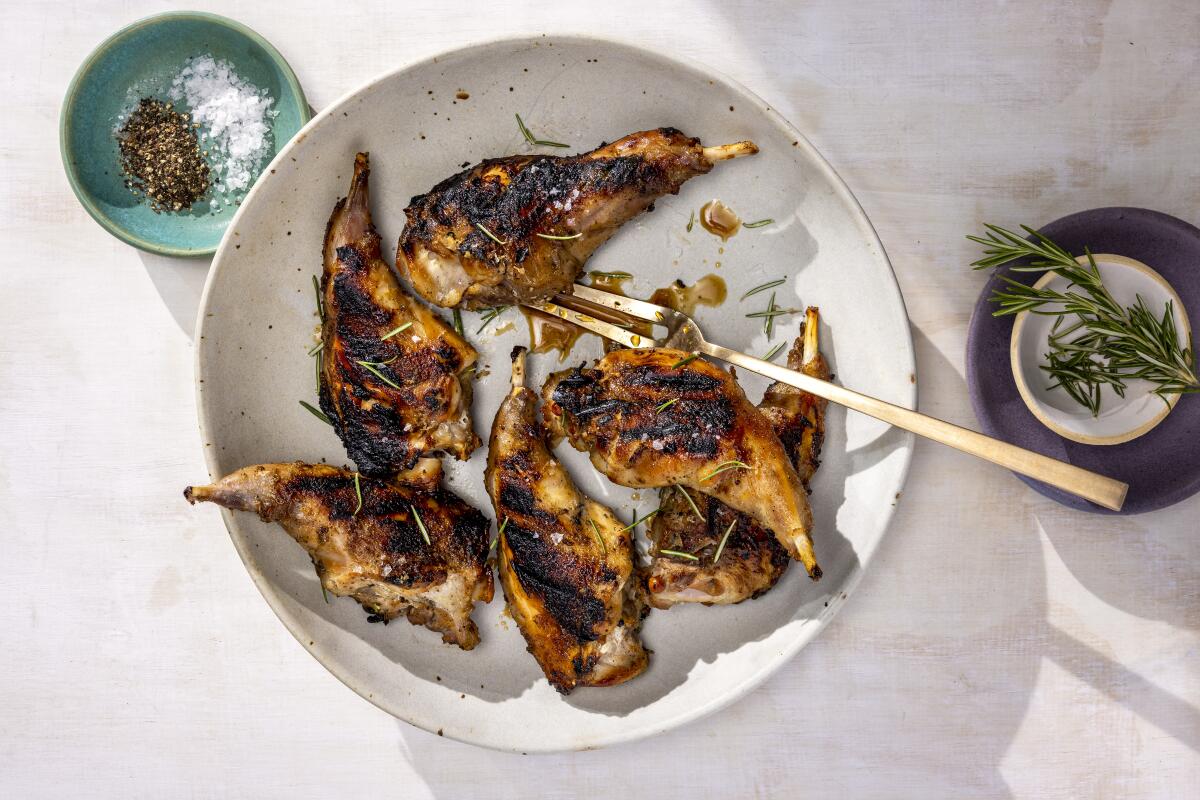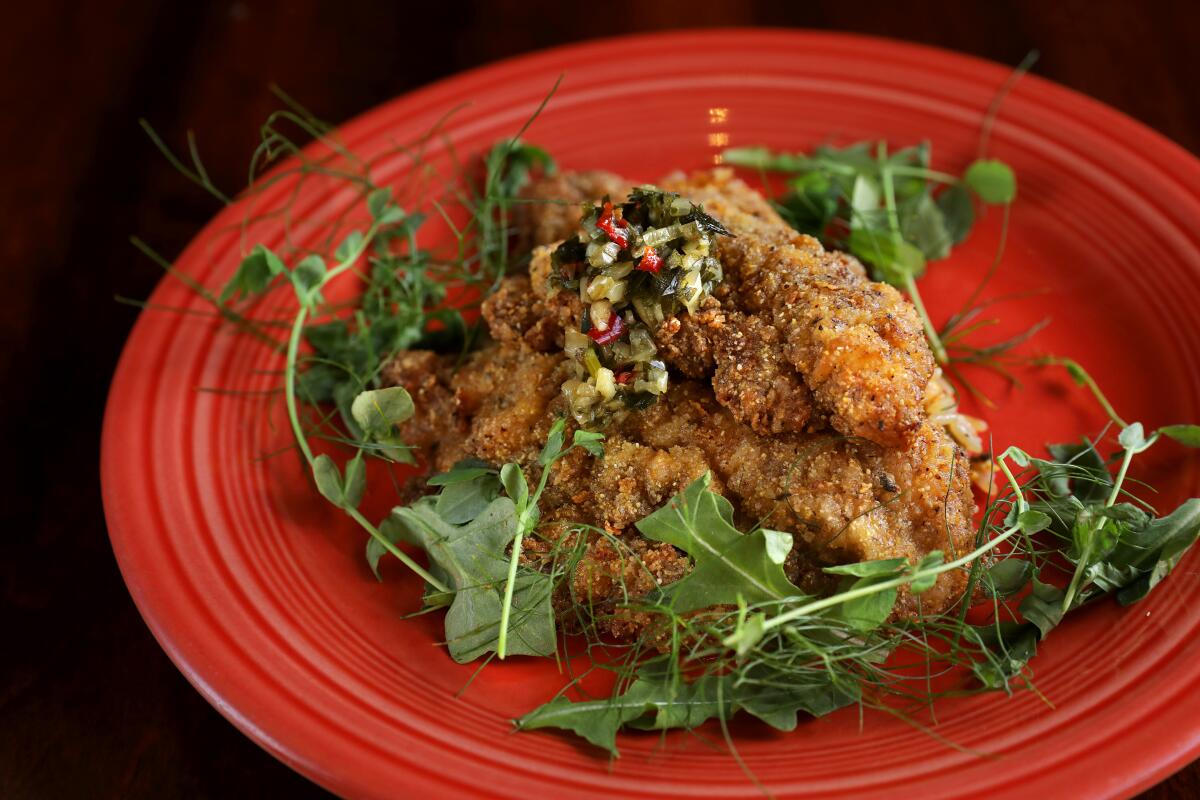5 recipes that celebrate the vast contributions of the African diaspora

- Share via
You are reading our Cooking newsletter
Sign up to get a taste of Los Angeles — and the world — in your own home and in your inbox every Friday
You may occasionally receive promotional content from the Los Angeles Times.
Although recognition for a culture or heritage should never be limited to a single month, Black History Month serves as a reminder to prioritize learning and understanding the diverse communities that contribute to our country’s evolving identity.
Food is just one medium to explore the global influence and wide-ranging traditions of the African diaspora. Ingredients and cooking preparations provide insight into how distinct cultures and communities exchange culinary inspiration and how recipes adapt over time.
“The kitchen was the hub. It was the gathering and meeting spot,” said Kim Prince, who co-owns the Dulanville food truck with Greg Dulan of Dulan’s on Crenshaw and belongs to the family responsible for inventing Nashville-style hot chicken almost a century ago.
During a visit to the L.A. Times Kitchen, she said that her earliest memories involved visiting the hot chicken stand her family owned in Nashville. But she has traced her family’s cooking history back much further.
“I found that it started with my third great-grandmother,” said Prince. “She was the head cook at a plantation in Brentwood, Tenn. The discovery of that made all of the light bulbs go off.”
Prince went down a rabbit hole of exploring the techniques and recipes that defined those early kitchens and found a common thread: chicken. Following in her family’s footsteps, she opened Hotville Chicken, a restaurant dedicated to Nashville hot chicken and soul food specialties, in the Baldwin Hills-Crenshaw Plaza in December 2019. The restaurant closed in late 2023, but Prince remains a pivotal figure within L.A.’s Black food scene.
With the Black Pot Supper series, chef Martin Draluck sought to educate diners about some of America’s earliest and most impactful Black culinary figures, including chefs James Hemings and Hercules Posey, who were enslaved by Presidents Thomas Jefferson and George Washington, respectively. The pair of chefs were responsible for bringing now-quintessential dishes such as French fries, macaroni and cheese and ice cream into the American culinary lexicon.
Held at Post & Beam, a California soul destination restaurant that is set to close at the end of this month, Draluck’s dinners also drew inspiration from his personal background, including his early career as a pastry chef, and from his grandfather James Howard, who grew up picking cotton in Texas and went on to run Dem Bones Bar B-Que Shack for 30 years in West L.A.
To connect to local and international Black food history, try making a spread with these five recipes, including an okra gumbo that adds matzo balls as a way of honoring the ties between Black, Southern and Jewish cuisines and sautéed collard greens with ginger and garlic that serves as a staple dish in Kenya.
Eating out this week? Sign up for Tasting Notes to get our restaurant experts’ insights and off-the-cuff takes on where they’re dining right now.
Grilled Rabbit Legs
Culinary historian and chef Draluck cites rabbit as one of his favorite meats. It’s also easily hunted and once helped sustain enslaved people who were provided meager rations. Draluck compares it to chicken and says that many of the same techniques can be applied. You can also substitute rabbit with chicken legs if that’s more accessible.
Get the recipe.
Cook time: 90 minutes, plus up to a day for brining. Serves 8 to 10.

Fried Jerked Catfish From Post & Beam
The four-year-running 101 Best Restaurant Post & Beam will close at the end of this month as the surrounding Baldwin Hills-Crenshaw Plaza undergoes redevelopment. Co-owner and chef John Cleveland says the restaurant will continue in some form, whether as a pop-up or at a new location. Next time you’re craving the comfort of the South L.A. restaurant’s warm dining room and California soul dishes, try making the signature fried jerked catfish, one of its most popular plates. Fresh fillets are preferred for this recipe, but frozen ones will do in a pinch.
Get the recipe.
Cook time: 20 minutes, plus up to 4 hours for marinating.

Enjoying this newsletter?
Consider becoming a Times subscriber.
Okra Gumbo
This dish from culinary historian Michael Twitty blends influences across Southern and Jewish cuisines by adding matzo balls to okra gumbo, combining two recipes from his food memoir “Koshersoul.” Resisting the label of fusion, Twitty describes the dish as an homage to flavors that highlights the intersections between distinct culinary traditions.
Get the recipe.
Cook time: 2 hours. Serves 6.

Sukuma Wiki
This simple recipe from Kiano Moju’s “AfriCali” cookbook is a staple in Kenya, and can be eaten on its own or as a side. To achieve the thin, noodle-like tendrils, you’ll remove the stalks from the collard green leaves and roll them into a tight cylinder before chopping ¼-inch slices with a sharp knife. Fresh tomato, garlic and ginger add complex flavors to the finished dish.
Get the recipe.
Cook time: 35 minutes. Serves 4 to 6.

Peach Crisp With Thyme
This approachable dessert from Draluck combines sweet and savory with the addition of thyme to a cinnamon-y, graham cracker crumbly peach crisp. Frozen peaches work just fine if you can’t find fresh ones.
Get the recipe.
Cook time: 1 hour, plus resting time.

Have a cooking question?
Eat your way across L.A.
Get our weekly Tasting Notes newsletter for reviews, news and more.
You may occasionally receive promotional content from the Los Angeles Times.




